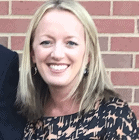The following is an interview with Alicia Tackitt, an educator with 20 years of experience in public education, who has served as a classroom teacher, reading interventionist, and instructional coach. Recently, she was part of a professional learning experience that challenged educators to think how they can challenge stereotypes about who is “good” at math.
What roles do stereotypes play in students’ self-perceptions of their abilities? How have you seen that manifested in the students you serve?
Many scholars perceive themselves as “bad” at a particular subject or at school in general. I have heard this in the way they speak about themselves when faced with a challenging problem to solve or text to read. I have seen this recently when they were writing their goals for 2021 and many scholars said they wanted to be “good” at math or become a “better” reader. Unfortunately, society has reinforced the idea that school is hard, and that math in particular is really hard. Simultaneously, society has, consciously or not, also reinforced an idea of the kind of person who is successful in mathematics–frequently excluding persons of color from the examples we celebrate of successful mathematicians. This influences students’ self-perceptions and what runs through their heads when faced with an academic challenge. Our school has prioritized training over the past few years in the implementation of a social-emotional learning curriculum that teaches the use of strategies such as self-talk (when students voice aloud the inner monologue all humans experience) to cope with feelings. Scholars are starting to use self-talk, but it is more often used in social situations, not academic challenges.
You recently engaged in professional learning with Leading Educators that challenged participants to come up with ideas to promote positive math identity for students. Tell us about that experience and the ideas you brainstormed.
Along with a team of teachers, I recently participated in professional learning with Leading Educators in which we learned about the power of counter-stereotypic imaging and began thinking about steps we could take to disrupt biases and what students internalize that they are capable of. We decided to create a visual display in our main hallway by the cafeteria for all scholars and staff to view. This display included images of mathematicians from marginalized groups to counter the stereotypical image of a white male mathematician. We placed mirrors around these images with a message reinforcing the idea that when scholars look into the mirror, they can identify themselves as a mathematician regardless of their race or gender.
Our teachers committed to calling our scholars “mathematicians” during math class and “scientists” during science class. The language we use matters. We believe that scholars will begin to identify themselves in these roles the more often they are referred to as mathematicians and scientists and the more opportunities they have to see examples of successful adults in these roles who look like them!
What are a few simple ideas/changes teachers can implement right away to start making a difference in students self-perceptions?
Acknowledge the fact that implicit bias exists and our society often perpetuates many stereotypes. Commit as a school to this work and continually ask, “How can we disrupt implicit bias?” Begin to surround your scholars with images of mathematicians and scientists that are women and people of color. Refer to your scholars as “mathematicians” during math class and as “scientists” during science class. Fill classroom libraries with diverse text that reflects our entire population. These changes will be some of the first steps in changing scholars’ self-perceptions.
What impact have you seen on students in your school since you started doing some of the things you brainstormed during the professional learning session?
Our scholars have teachers who are aware of implicit bias and have committed to making changes that will counter stereotypes. As we continue this work we will begin to see more scholars with positive self-perceptions. This will increase engagement and strengthen their mindset towards math and science instruction. Their realm of future possibilities will grow– anyone can be a mathematician if they want to be one!
















